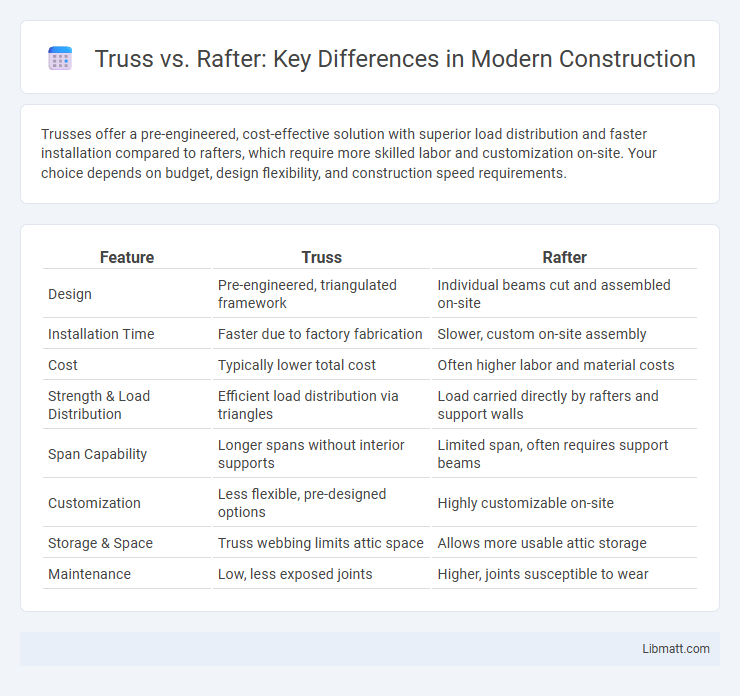Trusses offer a pre-engineered, cost-effective solution with superior load distribution and faster installation compared to rafters, which require more skilled labor and customization on-site. Your choice depends on budget, design flexibility, and construction speed requirements.
Table of Comparison
| Feature | Truss | Rafter |
|---|---|---|
| Design | Pre-engineered, triangulated framework | Individual beams cut and assembled on-site |
| Installation Time | Faster due to factory fabrication | Slower, custom on-site assembly |
| Cost | Typically lower total cost | Often higher labor and material costs |
| Strength & Load Distribution | Efficient load distribution via triangles | Load carried directly by rafters and support walls |
| Span Capability | Longer spans without interior supports | Limited span, often requires support beams |
| Customization | Less flexible, pre-designed options | Highly customizable on-site |
| Storage & Space | Truss webbing limits attic space | Allows more usable attic storage |
| Maintenance | Low, less exposed joints | Higher, joints susceptible to wear |
Introduction to Roof Framing: Truss vs Rafter
Roof framing options primarily include trusses and rafters, each offering unique structural benefits. Trusses are pre-fabricated, triangular wooden frameworks designed for uniform load distribution and faster installation, making them cost-effective and time-efficient for modern construction. Rafters consist of individual beams assembled on-site, providing greater design flexibility and easier modifications but requiring more labor and time.
What is a Roof Truss?
A roof truss is a pre-engineered structural framework composed of triangular units designed to support the roof load efficiently. Manufactured from wood or metal, trusses distribute weight evenly to exterior walls, reducing the need for interior load-bearing walls. This system allows for faster construction, greater design flexibility, and enhanced load-bearing capacity compared to traditional rafters.
What is a Rafter Roof System?
A rafter roof system consists of individual rafters, which are sloped structural beams running from the ridge board at the roof's peak down to the exterior walls, providing the main support for the roof deck and covering. This traditional framework allows for flexible roof designs and easier modifications but requires more precise carpentry and labor compared to prefabricated truss systems. Rafters offer clear exposure of the attic space, facilitating ventilation and storage options within the roof structure.
Structural Differences: Truss vs Rafter
Trusses consist of prefabricated triangular units engineered to distribute weight evenly across multiple points, providing greater strength and stability compared to rafters. Rafters are individual sloped beams that support roof loads but rely heavily on wall framing and require additional bracing to prevent sagging. Choosing between trusses and rafters impacts your roof's structural integrity, installation time, and overall load distribution.
Installation Process: Trusses vs Rafters
Trusses offer a faster and more efficient installation process since they arrive pre-fabricated and engineered for precise fitting, reducing on-site labor and construction time. Rafters require more skilled craftsmanship and longer installation time as each piece is measured, cut, and assembled individually on-site, providing greater customization but increasing complexity. Your choice will impact project timelines and labor costs depending on whether speed or flexibility is your priority.
Cost Comparison: Truss vs Rafter
Trusses generally offer a more cost-effective solution compared to rafters due to their prefabricated design, which reduces labor and construction time. Rafters, while providing more customization and aesthetic flexibility, often increase expenses because they require skilled craftsmanship and longer installation periods. Overall, trusses lower upfront costs and minimize waste, making them a budget-friendly choice for most roofing projects.
Design Flexibility and Customization
Trusses offer limited design flexibility due to their pre-engineered components, making them ideal for standardized roof shapes but less adaptable to unique architectural styles. Rafters allow greater customization, enabling you to create complex roof designs and accommodate irregular floor plans with precision. Choosing rafters supports personalized aesthetics and structural adjustments, enhancing your home's uniqueness.
Durability and Load-Bearing Capacity
Trusses provide superior durability and load-bearing capacity compared to traditional rafters due to their engineered design, which evenly distributes weight across multiple points. Rafters, typically made from solid wood, offer good strength but may require additional support to handle heavy loads or long spans. When planning your roof structure, choosing trusses can enhance stability and longevity, especially for larger or more complex roofing projects.
Maintenance Requirements
Trusses require less maintenance compared to rafters due to their factory-built precision and uniform design, which reduces the risk of structural issues over time. Rafters, being custom-built on-site, may need more frequent inspections and repairs to address potential warping, cracking, or pest infestations. Understanding these maintenance differences helps you plan for long-term roof care and cost management.
Choosing the Right Option: Factors to Consider
Selecting between truss and rafter roof systems depends on factors such as structural load requirements, budget constraints, and architectural design preferences. Trusses offer pre-engineered strength and faster installation, ideal for large spans and cost efficiency, while rafters provide more flexibility for custom roof shapes and attic space. Consider local building codes, material availability, and long-term maintenance needs to determine the most suitable roofing framework for your project.
Truss vs Rafter Infographic

 libmatt.com
libmatt.com